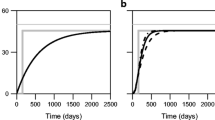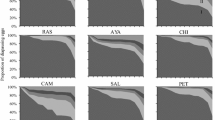Abstract
Most species of rotifers have a combination of sexual and asexual reproduction, with sexual reproduction resulting in resting eggs, which can lay dormant for long periods. The occurrence of sexual reproduction affects population dynamics through the temporary presence of male rotifers, and a reduction in the growth of the number of female rotifers. A previously published, individual-based model used dynamic energy budget theory to describe rotifer food intake, growth, egg production, and mortality, but assumed asexual reproduction only. In the current study, we have expanded the model to describe the entire reproductive cycle of the rotifers, making it usable for investigating relationships, such as those between the signal triggering mictic egg production, and the timing and number of resting eggs produced. The model is intended for use in predicting the specific future development of cultures, for instance, as a process model in rotifer or resting egg production for aquaculture.





Similar content being viewed by others
References
Alver, M. O., J. A. Alfredsen & Y. Olsen, 2006. An individual-based population model for rotifer (Brachionus plicatilis) cultures. Hydrobiologia 560: 93–108.
Aparici, E., M. J. Carmona & M. Serra, 1998. Sex allocation in haplodiploid cyclical parthenogens with density-dependent proportion of males. American Naturalist 152: 652–657.
Carmona, M. J., M. Serra & M. R. Miracle, 1993. Relationships between mixis in Brachionus plicatilis and preconditioning of culture medium by crowding. Hydrobiologia 255/256: 145–152.
Gilbert, J. J., 1974. Dormancy in rotifers. Transactions of the American Microscopical Society 93: 490–513.
Gomez, A. & M. Serra, 1996. Mate choice in male Brachionus plicatilis rotifers. Functional Ecology 10: 681–687.
Hagiwara, A., K. Hamada, S. Hori & K. Hirayama, 1994. Increased sexual reproduction in Brachionus plicatilis (Rotifera) with the addition of bacteria and rotifer extracts. Journal of Experimental Marine Biology and Ecology 181: 1–8.
Hagiwara, A., A. Hino & R. Hirano, 1988. Effects of temperature and chlorinity on resting egg formation in the rotifer Brachionus plicatilis. Nippon Suisan Gakkaishi 54: 569–575.
Hino, A. & R. Hirano, 1976. Ecological studies on the mechanism of bisexual reproduction in the rotifer Brachionus plicatilis – I. General aspects of bisexual reproduction inducing factors. Bulletin of the Japanese Society of Scientific Fisheries 42: 1093–1099.
Holling, C. S., 1965. The functional response of predators to prey density and its role in mimicry and population regulation. Memoirs of the Entomological Society of Canada.
King, C. E. & M. R. Miracle, 1980. A perspective on aging in rotifers. Hydrobiologia 73: 13–19.
Kooijman, S. A. L. M., 2000. Dynamic energy and mass budgets in biological systems. Cambridge University Press.
Lubzens, E., Y. Wax, G. Minkoff & F. Adler, 1993. A model evaluating the contribution of environmental factors to the production of resting eggs in the rotifer Brachionus plicatilis. Hydrobiologia 255/256: 127–138.
Pourriot, R. & T. W. Snell, 1983. Resting eggs in rotifers. Hydrobiologia 104: 213–224.
Scheffer, M., J. M. Baveco, D. L. DeAngelis, K. A. Rose & E. H. Van Nes, 1995. Super-individuals a simple solution for modelling large populations on an individual basis. Ecological Modelling 80: 161–170.
Serra, M. & M. J. Carmona, 1993. Mixis strategies and resting egg production of rotifers living in temporally-varying habitats. Hydrobiologia 255/256: 117–126.
Serra, M., T. W. Snell & J. J. Gilbert, 2005. Delayed mixis in rotifers: an adaptive response to the effects of density-dependent sex on population growth. Journal of Plankton Research 27: 37–45.
Snell, T. W. & B. L. Garman, 1986. Encounter probabilities between male and female rotifers. Journal of Experimental Marine Biology and Ecology 97: 221–230.
Snell, T., J. Kubanek, W. Carter, A. B. Payne, J. Kim, M. K. Hicks & C. P. Stelzer, 2006. A protein signal triggers reproduction in Brachionus plicatilis (Rotifera). Marine Biology 149: 763–773.
Stelzer, C. P. & T. W. Snell, 2003. Induction of sexual reproduction in Brachionus plicatilis (Monogononta, Rotifera) by a density-dependent chemical cue. Limnology and Oceanography 48: 939–943.
Vadstein, O., G. Øie & Y. Olsen, 1993. Particle size dependent feeding by the rotifer Brachionus plicatilis. Hydrobiologia 255/256: 261–267.
Walpole, R. E., R. H. Myers & S. L. Myers, 1998. Statistics for engineers and scientists. Prentice Hall International.
Author information
Authors and Affiliations
Corresponding author
Additional information
Guest editors: S. S. S. Sarma, R. D. Gulati, R. L. Wallace, S. Nandini, H. J. Dumont & R. Rico-Martínez
Advances in Rotifer Research
Rights and permissions
About this article
Cite this article
Alver, M.O., Hagiwara, A. An individual-based population model for the prediction of rotifer population dynamics and resting egg production. Hydrobiologia 593, 19–26 (2007). https://doi.org/10.1007/s10750-007-9043-z
Published:
Issue Date:
DOI: https://doi.org/10.1007/s10750-007-9043-z




